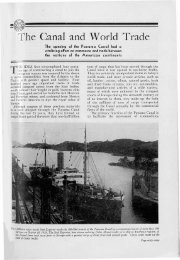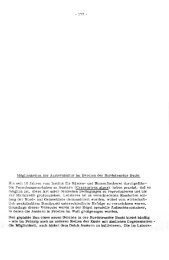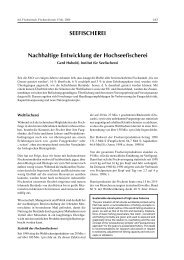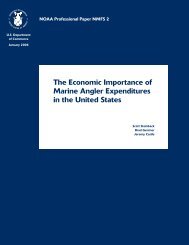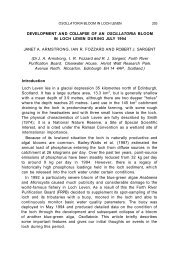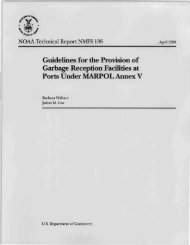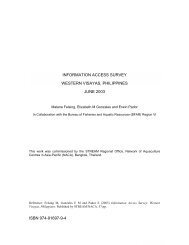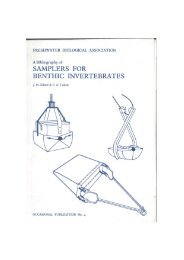Download - Aquatic Commons
Download - Aquatic Commons
Download - Aquatic Commons
Create successful ePaper yourself
Turn your PDF publications into a flip-book with our unique Google optimized e-Paper software.
Rationale and Scope Macroinvertebrate Checklists Camp et al. 1998<br />
separate investigations, we can help to ensure that the<br />
same animal will be consistently identified by the same<br />
name and that the name selected will be based upon<br />
the most accurate information. Problems posed by reclassifications<br />
or by the appearances of “new”(undescribed,<br />
recently described, or extralimital) species<br />
can be mitigated by periodic and timely updates of the<br />
guides.<br />
A first step in producing identification guides is to<br />
prepare authoritative, up-to-date checklists of all<br />
species of the major marine benthic macroinvertebrate<br />
groups known from shallow Florida waters. Such<br />
checklists will serve two purposes—they will provide<br />
ecologists with up-to-date names for most of Florida’s<br />
benthic macroinvertebrates, and they will provide a<br />
basis from which to plan the scope and production of<br />
illustrated guides to the marine fauna of Florida. The<br />
purpose of this paper is to initiate that first step. An<br />
electronic network (perhaps via an Internet website)<br />
should also be established to allow easy access to the<br />
checklists and to inform Florida ecologists of nomenclatural<br />
changes to the checklists and of associated<br />
identification literature.<br />
The checklists of mollusks, polychaetous annelids,<br />
malacostracan crustaceans, and echinoderms that follow<br />
list all species of these groups known to occur in<br />
Florida’s estuarine and coastal marine waters offshore<br />
to depths of approximately 37 meters (20 fathoms or<br />
120 feet).The 37-m depth was selected as a deep-water<br />
boundary because this depth has been shown to be an<br />
approximate point of transition between the faunas of<br />
shallow coastal zones and those of intermediate and<br />
deeper shelf zones, at least off western Florida (Lyons,<br />
1980; Lyons and Camp, 1983). Although such points of<br />
transition can differ between animal groups and, certainly,<br />
among locations in a region as large and environmentally<br />
diverse as Florida, we have found that<br />
many of the species that demonstrate fidelity to particular<br />
depth zones off western Florida maintain that<br />
fidelity in other areas of the state. As a caveat to that<br />
generalization, it is important to recognize the phenomenon<br />
of latitudinal submergence—species that<br />
inhabit very shallow waters in the Florida Keys and<br />
along southeastern Florida may be found only in deeper<br />
waters farther north. However, the converse is seldom<br />
true—benthic macroinvertebrate species that customarily<br />
inhabit Florida’s intermediate and deeper<br />
shelf communities are rarely found in inshore waters<br />
of Florida (although a few occur in lesser depths off<br />
New England).<br />
The checklists should not be considered a complete<br />
listing of all species that live in Florida waters, because<br />
undescribed species in museum collections are<br />
usually not included, and many species currently<br />
known only from nearby states and countries (e.g., Bahama<br />
Islands, Cuba) could also occur in Florida waters.<br />
These lists are works in progress, and they should be<br />
updated regularly. Compilation of this version ended<br />
in November 1997.<br />
Individual accounts of methods and acknowledgments<br />
related to the creation of each list are presented<br />
below, and the list for each group is accompanied by<br />
a separate compilation of pertinent literature.The references<br />
cited in those compilations include all literature<br />
sources consulted during the preparation of that<br />
list, as well as some other references useful in classifying<br />
and identifying organisms of that group. Many<br />
other references have also been included to guide the<br />
user to pertinent information on the communities in<br />
which the organisms live and the forces that may impact<br />
those organisms and their communities; however,<br />
the lists of references do not include all papers<br />
that have treated Florida’s benthic invertebrates. The<br />
sound management of Florida’s marine resources will<br />
depend not only upon the consistent and accurate<br />
identification of organisms but also upon an understanding<br />
and appreciation of the composition and dynamics<br />
of the communities in which these organisms<br />
live.<br />
Acknowledgments<br />
We thank the following people, who contributed their<br />
time and effort to improving the quality of this checklist.<br />
Staff of the library at Florida Marine Research Institute<br />
(FMRI) (Jan Boyett, Bob Brock, Felice Drouin, and<br />
James Thomas) acquired and provided copies of many<br />
of the publications we consulted. James F. Quinn, Jr.,<br />
Llyn French, and Judy Leiby, of the FMRI Publications<br />
Production Office, edited our copy, assembled our several<br />
word-processing files into the finished document,<br />
and assisted in improving this work. Funding was provided<br />
by Florida Department of Environmental Protection,<br />
Division of Water Facilities, Bureau of Water Resources<br />
Protection from FY 1997 U.S. Environmental<br />
Protection Agency 604(b) grant monies administered<br />
by Mary Paulic. We are grateful to the department for<br />
giving us the opportunity to assemble these lists and<br />
associated references. Finally, we are especially grateful<br />
to Paul Humann, marine life author and photographer,<br />
for allowing several of his excellent photographs<br />
to grace the cover of this document.<br />
Literature Cited<br />
CARNEY, R. S. 1996. On the adequacy and improvement<br />
of marine benthic pre-impact surveys. Pp. 295-315 in<br />
Schmitt, R. J., and C.W. Osenberg (eds.), Detecting Eco-<br />
2 FMRI Technical Report TR-3



